Music
“An Evening with Alan Menken” showcased the music of this Academy Award-winning composer
JHM guest columnist Alex Ogle takes us to Lincoln Center, where the man behind the songs in “The Little Mermaid,” “Beauty and the Beast” and “Aladdin” recently shared stories about his work on these classic Disney animated features

As my friend Emily and I found our seats on the far right of the mezzanine, I
couldn’t help but overhear the man seated next to us. He turned to his two
companions and said: “I’m not sure who’s playing tonight. I think he’s some
children’s composer.”
Hardly. Academy Award-winning composer Alan Menken may be many things. But he is not
just “… some children’s composer.” Having written the music for many of Walt Disney
Studios’ most successful animated features over the past two decades, Menken is
a man who definitely deserves his moment in the sun. Which is exactly what Alan
got back on February 20th, when hundreds of musical theater fans
made their way to NYC’s Lincoln Center to experience “An Evening with Alan
Menken.”
To set the scene a bit, this performance took place in the Allen Room, which has
to be one of the most beautiful performance spaces in the city. This is a 600-seat
room right above the lobby of the Time Warner Center, the building that housed
Patrick Dempsey’s law office in “Enchanted.” The kicker is that the wall behind the stage is completely made of glass, which gave the audience an amazing view of Columbus Circle, Central Park, and the Upper East Side skyline in the distance.
Copyright 2009 Lincoln Center. All Rights Reserved
As the lights went down, a silhouette slowly walked up to the piano, sat down, and
the opening strains of “Beauty and the Beast”
began. Mr. Menken’s
voice, although certainly the voice of a composer more so than a performer, was
so inviting and soothing, everyone in the Allen Room immediately recognized
that they were in something special.
As the lights came up at the close of “Beauty and the Beast,” Alan turned to the
audience and thanked everyone for coming. Menken made it clear that he was
excited that night, mentioning that he hadn’t performed with a band in
something like twenty-five years.
As part of his introduction for the program’s next number, “Mean Green Mother from
Outer Space” from “Little Shop of Horrors
,“ Alan said “This next song was nominated for an Academy Award.” He then quipped “You’re going to be hearing that a lot tonight.” Which is
understandable, given that Menken has been nominated for 18 Oscars and won 8. Which is more than any other living composer.
Copyright 2000 Warner Home Video. All Rights Reserved
Throughout that evening’s performance, in between each of the songs, Alan would share a bit
of history about what was going on in his life at the time of each project. And
these stories were some of the best parts of “An Evening with Alan Menken.”
Take – for example — “Out There” from “The Hunchback of Notre Dame.” As part of his
introduction for this song, Alan talked about his somewhat unique collaboration
method with Stephen Schwartz. Although these two men obviously enjoy working
together, at least once during their writing sessions Menken had to tell
Schwartz to just leave the room. Alan then joked that he was the one who was
truly responsible for the success of Stephen’s smash hit, “Wicked.”
One of the real highlights of “An Evening with Alan Menken” was hearing Menken perform “Suddenly Seymour” from “Little Shop of Horrors.” This is one of my favorite songs from the Ashman / Menken catalog. And as I listened to his somewhat quirky singing voice, I suddenly realized that Alan Menken is Seymour Krelborn.
I Copyright 2004 Disney. All Rights Reserved
Speaking of Howard Ashman, Alan shared a story about “Proud of Your Boy,” a song that he
& Howard wrote for “Aladdin” before Ashman passed away in March of 1991. A rewrite
of “Aladdin” ‘s storyline resulted in “Proud of Your Boy” being dropped from
that animated feature. But when Disney decided to include this song as an extra
feature on the “Aladdin” DVD that the Company released in October of 2004, Menken
recalled being overcome with emotion at that recording session. To hear Clay
Aiken singing Howard’s heartfelt lyric in front of a full orchestra brought
back how much Alan missed his old writing partner.
Truth be told, Menken talked a lot about Ashman during his performance in the Allen
Room. He recalled how Howard had really wanted to work on “Newsies,” but that Ashman
had been too sick at that time to take on the project.
Music from “Newsies” was not the only pleasant surprise of the night. Music from
another one of Menken’s under-appreciated projects, “Home on the Range,” was featured
as well. As he introduced “Will the Sun Ever Shine Again,” Alan recalled how
everyone at Walt Disney Studios felt like this song perfectly put into words
what they were feeling in the wake of September 11th.
Copyright 2009 Stage Entertainment. All Rights Reserved
Another highlight of “An Evening with Alan Menken” was hearing songs that haven’t ever been recorded. Take – for example – “Pink Fish,” which is a song that Alan wrote when he was still an aspiring young performer from Texas. “Pink Fish” is a comic number told from the perspective of a kid from
the South who has never before encountered bagels & lox and other aspects
of NYC’s deli culture. Having grown up in the suburbs of Pittsburgh and never
having experienced a smoked salmon shmeer ‘til I moved to the city a few weeks
ago, I immediately got what this character was singing about.
There were so many high points to this evening’s entertainment (EX: Menken previewing a number from his new stage musical version of “Sister Act”), that it’s genuinely hard to pick out the high point. Though – that said – it was pretty amazing to be able hear Alan sing “That’s How
You Know” from “Enchanted” while being able to look out onto Central Park at the
very spot where this number from that
Disney film was shot.
Although Menken performed many of his songs performed with a band and some backup
singers (who he jokingly referred to as his “Menkenettes”), it was the numbers
that Alan performed solo that were the most moving. Those songs (more
importantly, his performances of these songs) gave you great insight into the
man who composed the music for some of The Walt Disney Company’s greatest
projects.
Alan Menken (L) with his longtime collaborator, Howard Ashman Copyright 1990 Disney. All Rights Reserved
As the evening drew to a close, Menken and his band first performed “A Whole New
World” from “Aladdin” and then did the title number for Alan’s hopefully-soon-to-be-produced
musical adaptation of the film “Leap of Faith.” Which quickly brought the
audience in the Allen Room to its feet, roaring their approval. On the heels of this ovation, Menken returned to the stage. And – for his
encore – performed “Colors of the Wind” from “Pocahontas.”
As I was walked away from Lincoln Center, I couldn’t help but think about my
companion up there in the mezzanine. You know, the guy who thought this evening’s
entertainment was going to be about “… some children’s composer”? Given the huge
contribution that Menken has obviously already made to the American songbook, I’m hoping that this man came away from the
Allen Room with a new appreciation of Alan’s artistry.
I know that I did.
Did you enjoyed reading Mr. Ogle’s review of “An Evening with Alan Menken” ? If so, then you should definitely check out his “Alex Takes Manhattan” blog, which details the three months that he recently spent exploring Manhattan.
Music
When you’re having “Yourself A Merry Little Christmas,” which version of this holiday classic do you prefer to sing?

“Have Yourself a Merry Little Christmas” had a pretty big year in 2016. Thanks to Josh Groban, this 72 year-old Hugh Martin / Ralph Blane tune reached No. 1 on Billboard’s adult contemporary charts.

Copyright Reprise / Warner Bros. All rights reserved
Mind you, this isn’t the only time in recent memory that this holiday song has charted. Back in 2014, Sam Smith’s cover of “Merry Little Christmas” made it into Billboard’s Hot 100. And Michael Bublé’s version did equally well back in 2011.
Which is pretty impressive. Especially when you take into consideration that – in spite of its rather ironic title — “Have Yourself a Merry Little Christmas” is actually one of the saddest holiday songs ever written.
Mind you, it used to be even sadder. When Martin & Blane originally wrote this tune for MGM’s 1944 musical, “Meet Me in St. Louis,” it was supposed to musically comment on that moment in this motion picture where the Smith family had just learned that – due to Father’s promotion – they’d now all have to move to New York and thus miss out on seeing the 1904 World’s Fair.
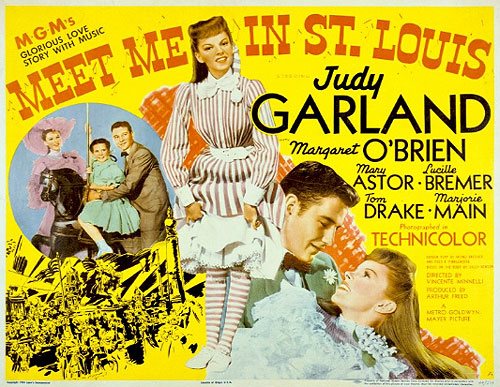
Copyright Warner Bros. Entertainment. All rights reserved
So – as older sibling Esther (played by Judy Garland) attempted to console her heart-broken little sister Tootie (played by Margaret O’Brien) during a scene set on Christmas Eve, Ralph & Hugh had originally envisioned “Have Yourself a Merry Little Christmas” getting underway by having Garland’s character sing:
Have yourself a merry little Christmas
It may be your last
Next year we may all be living in the past
Have yourself a merry little Christmas
Pop that champagne cork
Next year we may all be living in New York.
Judy balked at singing these lyrics as written, arguing that – if her character actually said something like that to her little sister – Esther would wind up traumatizing poor Tootie. Which would then make the audience hate her character. And when “Meet Me in St. Louis” director Vincente Minnelli (who would go on to marry Garland the following year) backed up his star, Martin & Blane were forced to soften this song’s opening stanza.
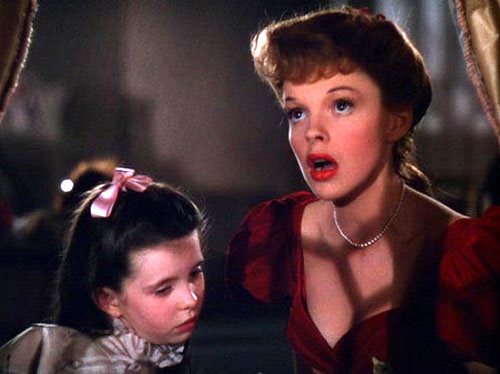
Copyright Warner Bros. Entertainment. All rights reserved
Have yourself a merry little Christmas
Let your heart be light
Next year all our troubles will be out of sight
Have yourself a merry little Christmas
Make the yuletide gay
Next year all our troubles will be miles away
When MGM released “Meet Me in St. Louis” to theaters in November of 1944, it was a smash hit for the studio. And Garland’s version of “Have Yourself a Merry Little Christmas” proved to be so popular during the waning days of World War II that Decca actually released two different versions of this recording over a 6-month period. One paired this holiday tune with another Martin & Blane song from “Meet Me in St. Louis,” “The Boy Next Door.” This version was then followed up by a Decca recording that paired “Have Yourself a Merry Little Christmas” with Garland’s performance of “You’re Never Walk Alone.” This Rodgers & Hammerstein song had quickly become a favorite after it was introduced in “Carousel,” which opened on Broadway back on April 19, 1945.
Barring some relatively minor tweaks to the song’s lyrics (i.e., “From now on” replacing the phrase “Next year”), this was the version of “Have Yourself a Merry Little Christmas” that was performed from 1944 – 1957.

Copyright Capitol Records, Inc. All rights reserved
“So what happened in 1957?,” you ask. Well, Old Blue Eyes went into the studio at Capital Records to record his very first full-length Christmas album, “A Jolly Christmas from Frank Sinatra.” Frank labored from May 1st through July 10, 1957 on this recording. Working in front of an orchestra conducted by Gordon Jenkins and backed up by the Ralph Brewster Singers, he put that distinctive Sinatra spin on such holiday favorites as “Jingle Bells,” “Silent Night,” and “I’ll be Home for Christmas.”
But when it finally came time to record Frank’s version of ‘Have Yourself a Merry Christmas,” Old Blue Eyes balked. Largely because Sinatra felt that the closing stanza of this song (as it was originally written for “Meet Me in St. Louis”) …
Someday soon we all will be together
If the fates allow
Until then, we’ll have to muddle through somehow
So have yourself a merry little Christmas now

Frank Sinatra recording at Capital Studios in Hollywood in the 1950s
… was far too bleak.
So Frank reached out to Hugh Martin and supposedly said that ” … I’m working on an album called ‘A Jolly Christmas.’ I’d really like to include ‘Merry Little Christmas’ on this recording, but that ‘ … muddle through’ line is a real downer. Do you think you could jolly up that line for me?”
And given that it was now the more hopeful 1950s … Well, Hugh agreed to tweak “Merry Little Christmas” ‘s lyrics for Frank. Swapping out ” … until then, we’ll have to muddle through somehow” for ” … hang a shining star upon the highest bough.” Which then allowed this still-bittersweet holiday song to end on a more upbeat note.
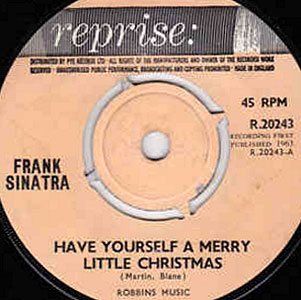
Copyright Reprise / Warner Bros. All rights reserved
And since the Sinatra version of “Have Yourself a Merry Little Christmas” became a smash hit … For nearly 50 years now, singers have had to make a hard choice whenever they decide to perform this holiday standard. Do they do as Judy did back in “Meet Me in St. Louis” and opt to ” … muddle through” what can often be a very emotional time of year? Or do they follow Frank’s example and offer a more hopeful view of the season? Literally reaching for the stars by hanging one ” … upon the highest bough” ?
Me? I have to admit that I’m one of those guys who embraces what Walt Disney once supposedly said (i.e.,”For every laugh, there should be a tear”). So I honestly don’t mind a little melancholy mixed in with my Merry Christmas. Which is why it kind of does my heart good to hear versions of “Have Yourself a Merry Little Christmas” like the one James Taylor performs. Where the original bittersweet message of this Martin & Blane song is basically left intact.
But how about you folks? When you’re having “A Merry Little Christmas,” which version of this holiday classic do you prefer? Are you a muddler like myself? Or do you prefer to hang a shiny star?
This article was originally published by the Huffington Post on Saturday, December 24, 2016
Music
Seth MacFarlane celebrates the classic Christmas albums of the 1940s & 1950s with “Holiday for Swing!”

So how much time does it take to craft a brand-new holiday
album that has a timeless sound?
To hear Joel McNeely (i.e., the Emmy Award-winning arranger
/ producer behind Seth MacFarlane's "Holiday for
Swing!") talk, it took a full year to lay down all 13 tracks for this
top-selling recording. Which honors the rich sound / orchestral jazz tradition of
those classic Christmas albums that Bing Crosby, Perry Como and Rosemary
Clooney performed on back in the 1940s & 1950s.

Copyright 2011 Universal Republic. All rights reserved
"What with his film work and all the TV series he rides herd on, Seth's schedule is just crazy these days. But he and I had such a good time working together on 'Music is Better than Words' that Seth were determined to carve out time necessary to record a second album," Joel explained during a recent phone interview. "Ironically it wasn't until 2012 when the two of us were over in England doing promo for that first album when the two of us realized that we both had the exact same weekend free. And since I already had six arrangements done for the holiday album that we had been talking about doing, Seth and I decided to get started recording. Which is when I made a quick call to Abbey Road."
Thankfully because of all the film work that he'd previously done at Abbey Road Studios, McNeely was able to pull in a few favors and book some time in Studio Two. And once he'd secured use of what many people consider the most famous recording studio in the world ("This is where the Beatles recorded," Joel enthused. "Which is why — if you're someone who works in the music field — you almost feel like you have to genuflect when you enter this space. I mean, the tinny piano that they used is still sitting there in the corner. You can walk right up and play it!"), he then reached out to some of London's best musicians.
"We even brought over Peter Erskine, the great jazz
drummer. Mind you, Studio Two is not a huge room. But we eventually wedged 54
players in there. But not a one of those musicians was off in an iso booth.
Everybody was in the same space. We had Peter and his drums right in the center
of the orchestra amongst all the strings and the woodwinds. So his sound was
leaking into all the other mics. And everybody else's sound was leaking into
everybody else's mics," McNeely said.
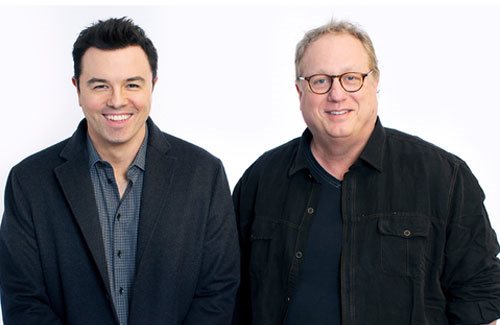
Seth MacFarlane and Joel McNeely
"And why was that important?," you ask. Because Seth and Joel were out to replicate a very particular sound from that era of recording. You see, when everyone's in the exact same space at the exact same time working on a track for an album, you get less of a pristine sound. And as a direct result, whatever you're recording then sounds more like a live performance.
"And given that all those classic holiday albums that
Ray Conniff and Dean Martin and Frank Sinatra did back in the day all have that
same sort of sound and feel … Well, Seth and I wanted this record to sound
like it had been part of that era as well. That 'Holiday
for Swing!' come across as this honest, completely sincere and authentic celebration
of all those great orchestral Christmas songs that were produced back in the
1940s and 1950s," McNeely stated.
So how did Seth & Joel go about choosing the holiday
songs that would be featured on this recording? Given that MacFarlane has an
almost encyclopedic knowledge of the great American songbook, McNeely opted to
let Seth choose the line-up for "Holiday for
Swing!"
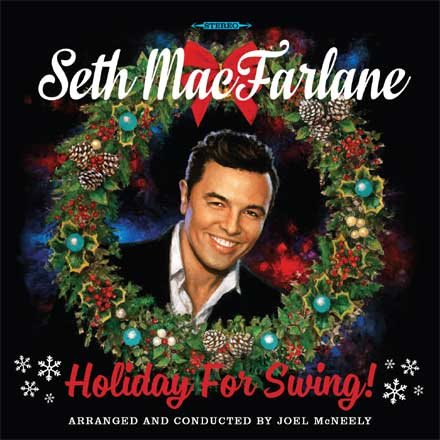
Copyright 2014 Universal Republic. All rights reserved
"Seth knows more obscure songs than anyone I've ever
worked with. On 'Music is Better than Words,' he just pulled all of these great
songs that I'd never heard of right out of his hat. Seth genuinely delights in
unearthing musical numbers that very few people have ever heard of before,"
Joel stated. "So that was what he wanted to do with this holiday album. Split 'Holiday
for Swing!' between those classic Christmas numbers that everyone knows and
those holiday songs that maybe you haven't heard before like 'Christmas
Dreaming' and 'Little Jack Frost Get Lost."
And what was Joel's job on this project? To come up with
orchestrations that he hoped would then make Seth laugh.
"Look, when you're working with a comedy professional,
you generally keep your jokes to yourself.
Because there's just no way that you can ever come with a gag that this
guy hasn't heard before or doesn't already know," McNeely explained.
"But what I can do — by making the orchestrations for these holiday songs
as fun as possible — is make Seth laugh with music. Try and tell a story with
each arrangement. Take — for example — 'Mele Kalikimaka.' The way that I orchestrated
this song for 'Holiday for Swing!,' it supposed to sound
like something straight out of a Bob Hope / Bing
Crosby Road picture. A moment from one of those movies where they enter
a jungle clearing and find this crazy witch doctor getting ready for Christmas.
That's just the sort of arrangement that I knew would make Seth laugh. And it
did."

Copyright Classic Media, LLC. All rights reserved
Mind you, not every witty reinvention of a holiday classic that
Joel dreamed up for "Holiday for Swing!" made
the final cut. Take — for example — Joel's bluesy take on "Frosty the
Snowman."
"When everyone else does 'Frosty,' they treat it as
this upbeat, bouncy tune. But if you actually listen to the lyrics, you then
realize that 'Frosty' is this really sad holiday song. I mean, he dies, the snowman
melts at the end of this song. So I thought that it might be fun to embrace the
sad story that those lyrics are actually trying to tell people. Turn 'Frosty
the Snowman' into this really dark, kind of bluesy dirge. But every which way I
went with that arrangement, it just felt false. I still believe in this
concept. I think that there's a genuinely funny take on this holiday classic in
there somewhere. But in the end, what Seth and I were looking to do with 'Holiday
for Swing!' was create a sincere, authentic Christmas album. Make something
that celebrated these songs, not do something that was mean-spirited or riffed
on these holiday classics. Which is why 'Frosty' never made it past the this-sounds-like-a-funny-idea
stage," McNeely said.
And once those first six holiday songs were laid down, what
with working on "Ted," "Family Guy," "American
Dad," "A Million Ways to Die in the West" and
"Cosmos," it would be another full year before Seth & Joel could
get then together again and record the last seven tracks for "Holiday for
Swing!"

Arranger / composer Joel McNeely
"And 'The Christmas Song' at the very end of this
album, that was just a Hail Mary. We were done recording and there was this
beautiful grand piano there in the recording studio. And I said 'Hey, you wanna
do this?' So we quickly up a mic and then did 'A Christmas Song' two times
straight through. And the second take is what you can now hear in its entirety
on the album. It was recorded live just with that piano. A simple and sincere
version of that song," McNeely recalled. "Which — to be honest — was
kind of the effect that I was going for. That — after all of the wackiness and
merriment that had preceded 'The Christmas Song' on 'Holiday
for Swing!' — I thought that it might be smart to put something quiet and
reflective at the end at this recording."
Well, clearly Christmas shoppers have approved of what Seth
& Joel put together. Given that — for a time — "Holiday
for Swing!" was the No. 1 recording for 2014. Just last week, this Universal
Republic recording occupied the
Number 8 position on Billboard's Holiday Album chart.
"Look, the fact that this album has been selling well is great
news. But from Seth's point of view, what really matters most is that the stuff
he loves — orchestral jazz — is getting out there again and being heard and
that people seem to be enjoying it," Joel stated. "I mean, you have
to understand that Seth doesn't take vacations. The way that he blows off steam
is by doing something he really loves. Which is singing. So when we were doing
promo for 'Holiday for Swing!' earlier this month and — in the span of one day
— Seth had to sing live on 'Good Morning America,' 'Live with Kelli and
Michael,' 'The View' and then finish that trip to NYC by performing on NBC's 'Lighting-of-the-Rockefeller-Center-Christmas-Tree'
TV program … I've honestly never seen the guy happier. These music projects
are just like candy to him."
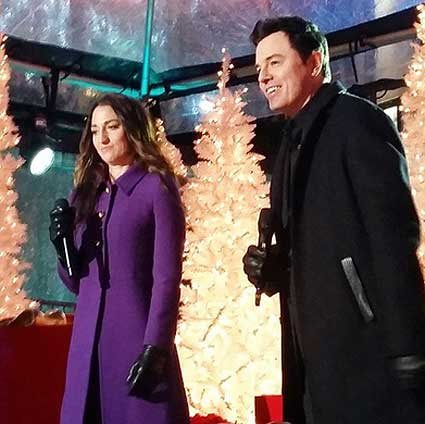
Sara Bareilles and Seth MacFarlane perform "Baby, It's Cold Outside" at
the 82nd Rockefeller Center Christmas Tree Lighting ceremony.
Copyright National Broadcasting Company. All rights reserved
Which perhaps explains why MacFarlane is already texting McNeely with ideas
and concepts for yet another album. One that Joel is really not free to talk
about at this point, but — should it ever actually come to pass (which, given
Seth's extremely packed schedule, is a very legitimate concern) — it could
possibly top the fun of "Music is Better than Words" and "Holiday
for Swing!"
FYI: If you'd like to see MacFarlane perform live, he'll be
singing on New Year's Eve with the San Francisco Symphony. Where — I'll bet
you — Seth will be performing Joel's arrangement of that Frank Loesser holiday
favorite, "What Are You Doing New Year's Eve?"
This article originally appeared on the Huffington Post's Entertainment page on December 24, 2014
Music
Sing Along with Mickey and Oswald in Epic Mickey 2: The Power of 2

Disney
Interactive Media Group and game designer, master storyteller and huge Disney
geek Warren Spector announced the sequel to last year's Wii game "Disney Epic Mickey
,"
with some changes that fans will love – or hate. The problems with the camera that plagued
Epic Mickey will be a thing of the past, and Oswald will be a playable,
speaking character.
Traditionalists
may argue that since Oswald never had a voice in his Disney shorts, he shouldn't
talk now. However, the majority of gamers who play the Epic Mickey games won't
know this, and might find a silent character off-putting. He DID speak in Epic
Mickey, but the sounds that emanated from the characters were more like sighs
and grunts, something Warren Spector stated (in Nintendo Power Magazine) was
akin to the classic Mario games.
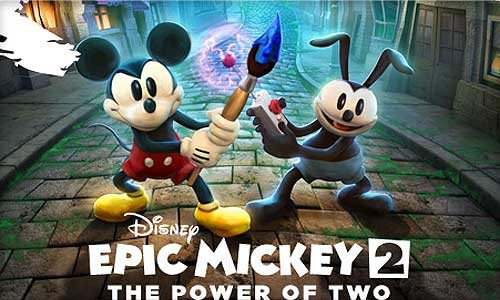
Copyright Disney Enterprises, Inc. All rights reserved
Not
only will the characters speak in Epic Mickey 2: The Power of Two, they will sing! Epic Mickey 2: The Power of Two will be a
classic Disney magical, musical adventure, with songs written especially for
the game by James Dooley ("Pirates Of The Caribbean: The Curse Of The Black Pearl
/ At World's End," "The Simpsons Movie") and Mike Himelstein ("Shrek," "Mickey Mouse Clubhouse") – note: Himelstein wrote the hilarious "Welcome to Duloc."
Oswald
will not only be a playable character for co-operative play (two people playing
together) but will also be a strong NPC (non-player character), with intuitive
AI (artificial intelligence). What do all these acronyms mean? It means that
even if you're playing alone as Mickey, Oswald will join you independently and
actually help you get along as the game progresses. This is a wonderful and
rare thing in the gaming world.

Copyright Disney Enterprises, Inc. All rights reserved
PlayStyle
Matters, which was explored a bit in the first game, will be further exploited
in the sequel. PSM means that the decisions you make as a player toward "good"
or "scrappy Mickey are actually reflected in later gameplay, Mickey with his
paint/thinner brush like in the first game, Oswald with a remote control that
controls electricity. In Epic Mickey,
Mickey actually changed his looks depending upon whether the player played him
as kind or not.
Disney Epic Mickey 2: The Power of Two
will be the first cross-platform Epic Mickey game,
playable not only on the Nintendo Wii
but also on the Xbox 360
and the PlayStation 3, introducing the story and characters to a much wider audience of
gamers.
-

 Theme Parks & Themed Entertainment9 months ago
Theme Parks & Themed Entertainment9 months agoDisney’s Forgotten Halloween Event: The Original Little Monsters on Main Street
-

 Theme Parks & Themed Entertainment9 months ago
Theme Parks & Themed Entertainment9 months agoThe Story of Mickey’s Not-So-Scary Halloween Party: From One Night to a Halloween Family Tradition
-

 Film & Movies9 months ago
Film & Movies9 months agoHow “An American Tail” Led to Disney’s “Hocus Pocus”
-

 Theme Parks & Themed Entertainment7 months ago
Theme Parks & Themed Entertainment7 months agoDisney and Macy’s 90-Year Thanksgiving Day Parade Partnership: From Mickey’s First Balloon to Minnie’s Big Debut
-

 Television & Shows5 months ago
Television & Shows5 months agoHow the Creators of South Park Tricked A-List Celebrities to Roast Universal – “Your Studio & You”
-

 History4 months ago
History4 months agoThe Super Bowl & Disney: The Untold Story Behind ‘I’m Going to Disneyland!’
-

 Film & Movies4 weeks ago
Film & Movies4 weeks agoBefore He Was 626: The Surprisingly Dark Origins of Disney’s Stitch
-

 Podcast2 months ago
Podcast2 months agoEpic Universal Podcast – Aztec Dancers, Mariachis, Tequila, and Ceremonial Sacrifices?! (Ep. 45)








